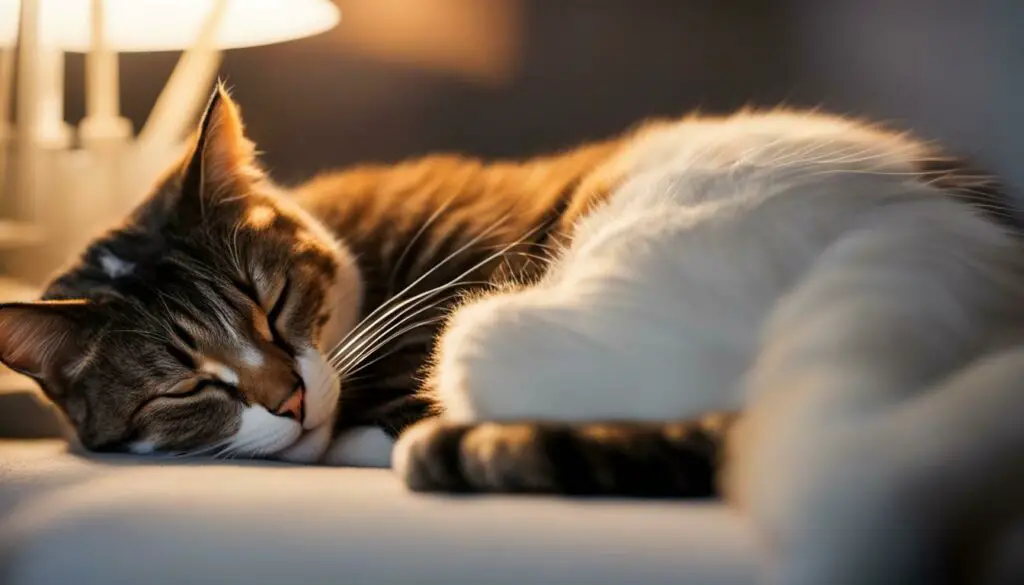Have you ever wondered why your cat chooses to sleep pressed up against you? Let’s delve into the fascinating world of feline behavior to unravel this mystery. Cats have their unique habits and preferences when it comes to sleep, and understanding why they choose to sleep so close to their owners can deepen our bond with these enigmatic creatures.
Key Takeaways:
- Cats often sleep pressed up against their owners due to feelings of trust and safety.
- Seeking warmth and comfort is another reason why cats choose to sleep close to their owners.
- Marking territory and showing affection are additional factors that may lead cats to sleep pressed against their owners.
- Cats may also seek comfort and reassurance from their owners during times of stress.
- It’s important to consider the risks and responsibilities associated with allowing cats to sleep with their owners and make informed decisions.
Trust and Safety: The Key Factors
Cats are known for their independent nature, but when they choose to sleep pressed up against their owners, it’s a clear sign of trust and a desire for safety. This behavior stems from the strong bond that develops between cats and their humans. By sleeping in close proximity, cats feel secure and protected, knowing that their owners are there to provide comfort and reassurance.
It’s important to note that trust is not built overnight. It takes time for a cat to feel safe enough to sleep in such a vulnerable position. Through consistent care and affection, a deep sense of companionship is established, allowing cats to feel comfortable snuggling up against their owners during sleep.
Creating a safe space for cats to sleep is essential in fostering this trust. Providing a warm and comfortable bed, away from any potential disturbances, ensures that cats can fully relax and enjoy a restful night’s sleep. Additionally, maintaining a consistent routine and environment helps to reinforce feelings of security and further strengthens the bond between cat and owner.
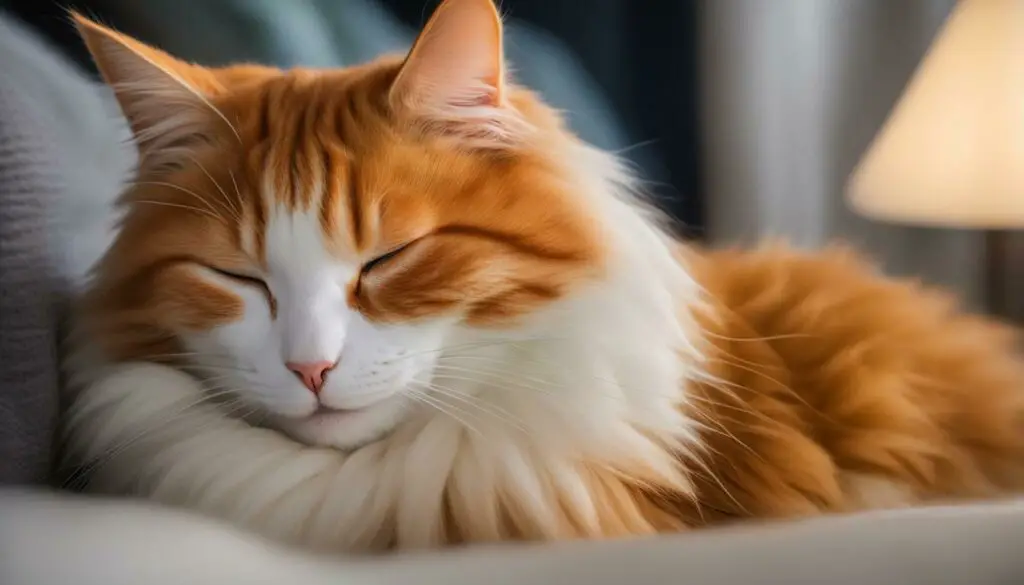 |
Sleeping close to their owners provides warmth and a sense of security for cats. |
|---|
While it’s understandable to want to share a bed with your furry companion, it’s important to be aware of the potential risks. Cats may bring contaminants, such as dirt or fleas, onto the bed, which can be unpleasant for both parties. Additionally, accidental harm can occur during sleep if the cat is startled or moves unpredictably. Therefore, it’s crucial to weigh the benefits of sleeping together against these potential risks and make a responsible decision based on individual circumstances.
In conclusion, when a cat chooses to sleep pressed up against its owner, it signifies a deep level of trust and a need for safety. This behavior is a testament to the strong bond between cat and owner, founded on love, companionship, and a sense of security. By understanding and nurturing this unique relationship, both the cat and the owner can enjoy a harmonious and mutually beneficial connection.
Seeking Warmth and Comfort
Cats are natural heat-seekers, and what better way to find warmth than by curling up next to their favorite heat source – their loving owner. Sleeping pressed up against their humans provides cats with the cozy and comforting environment they crave. It’s like having their own personal heating pad!
In addition to warmth, cats also seek comfort when they sleep. Being close to their owners allows them to feel safe and secure, knowing that they are in the presence of someone they trust. Cats are known for their independent nature, but even the most independent feline can benefit from a little extra comfort and reassurance during sleep.
When a cat sleeps pressed against their owner, it’s their way of saying, “I feel safe with you, and I trust you to protect me.” It’s a beautiful display of the bond and affection between humans and their feline companions. So, the next time your cat snuggles up to you at night, embrace the warmth and comfort they bring.
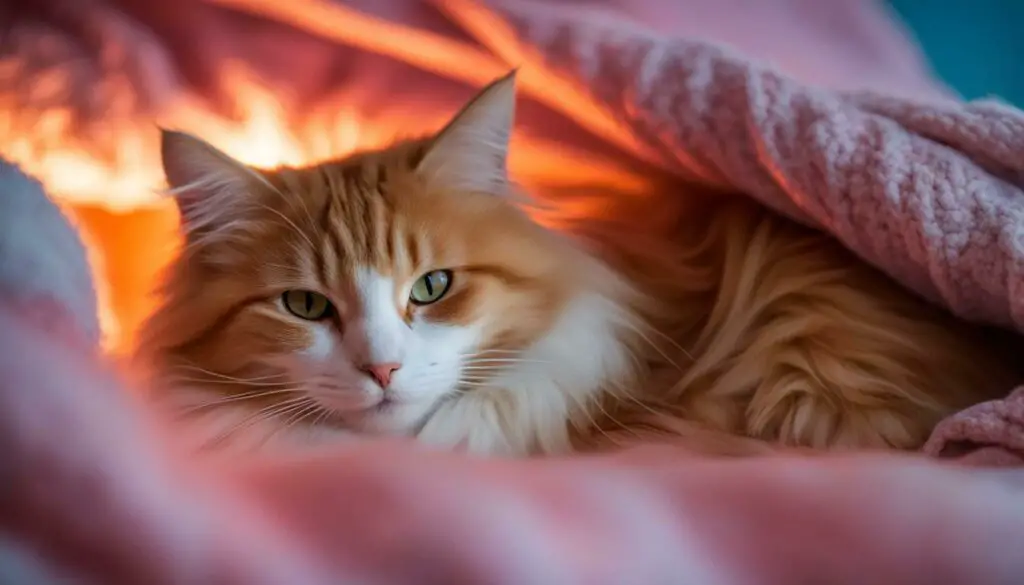
| Sleeping Position | Meaning |
|---|---|
| Curling into a ball | Feeling secure and protected |
| Sleeping belly up | Showing vulnerability and trust |
| Sleeping in a loaf position | Relaxed and comfortable |
“A cat will be your friend, but never your slave.” – Theophile Gautier
Marking Territory and Affection
When your cat chooses to sleep pressed up against you, they are not just seeking comfort, but also declaring their love and marking you as their own. Cats have a strong instinct to mark their territory, and by sleeping in close proximity to their owners, they are essentially claiming you as part of their territory. This behavior demonstrates the deep bond and affection they feel towards you, as they consider you an important and cherished part of their life.
Cat body language can provide insights into their feelings and intentions. When a cat sleeps pressed up against you, they are exhibiting signs of trust, contentment, and a desire for companionship. They feel safe and secure in your presence, and by sleeping with their body touching yours, they are seeking reassurance and comfort. This physical closeness not only helps them feel protected, but it also strengthens the bond between you and your feline companion.
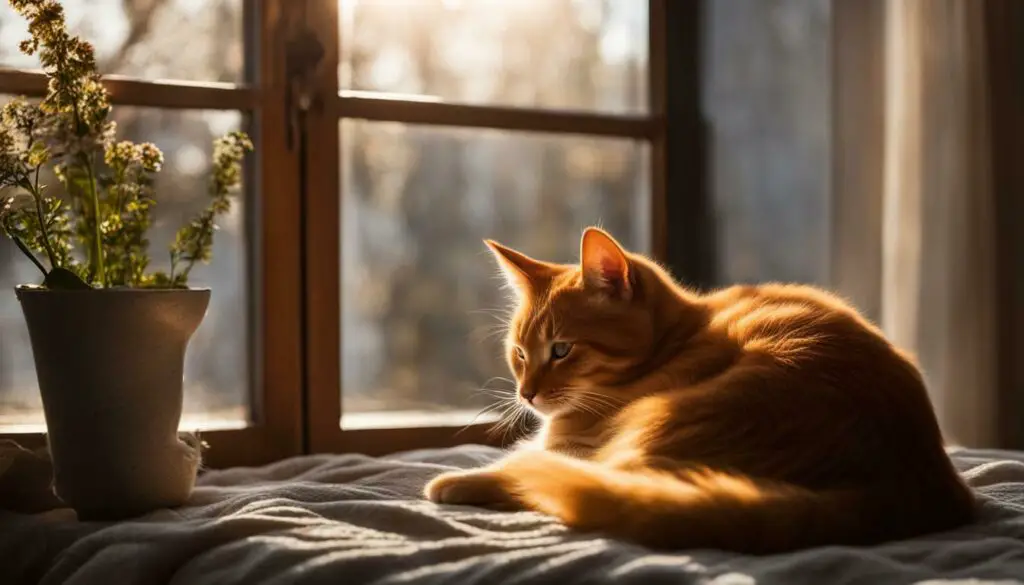
| Signs of Marking Territory and Affection | What They Mean |
|---|---|
| Pressing their body against you while sleeping | Claiming you as their territory and declaring their love |
| Purring and kneading on your body | Showing contentment and affection towards you |
| Rubbing their cheeks and body against you | Marking you with their scent and strengthening the bond |
Understanding and appreciating this behavior is crucial for maintaining a strong and positive relationship with your cat. By respecting their need for physical closeness and allowing them to sleep pressed up against you, you are nurturing their sense of security and reinforcing the emotional connection you share. So next time your feline friend chooses to curl up next to you for a cozy nap, know that it’s not just a simple sleeping position, but a heartfelt declaration of love and loyalty.
Comfort and Reassurance
Cats are incredibly sensitive creatures, and when they feel stressed or anxious, they often turn to their trusted owners for comfort and reassurance. This behavior extends to their sleeping habits as well. Sleeping pressed up against their owners provides a sense of security and allows cats to feel safe and protected.
When a cat snuggles up close to their owner, they are seeking physical contact and warmth, which in turn helps them feel calm and content. The familiar scent and presence of their owner can have a soothing effect on cats, helping them relax and unwind after a long day.
Moreover, sleeping close to their owners strengthens the bond between cats and humans. It reinforces the sense of trust and companionship between them, creating a deeper connection. Cats rely on their owners for companionship, and sleeping together is a way for them to express their love and affection.
“Cats are independent creatures, but they also crave love and attention. Sleeping pressed up against their owners is their way of showing that they trust and rely on them.”
However, it’s important to note that not all cats enjoy sleeping pressed up against their owners. Just like humans, cats have their own unique preferences when it comes to sleep. Some cats may prefer to sleep in their own designated areas, while others may enjoy the warmth and comfort of sharing a bed with their owners. It’s crucial to respect your cat’s individual needs and boundaries when it comes to sleeping arrangements.
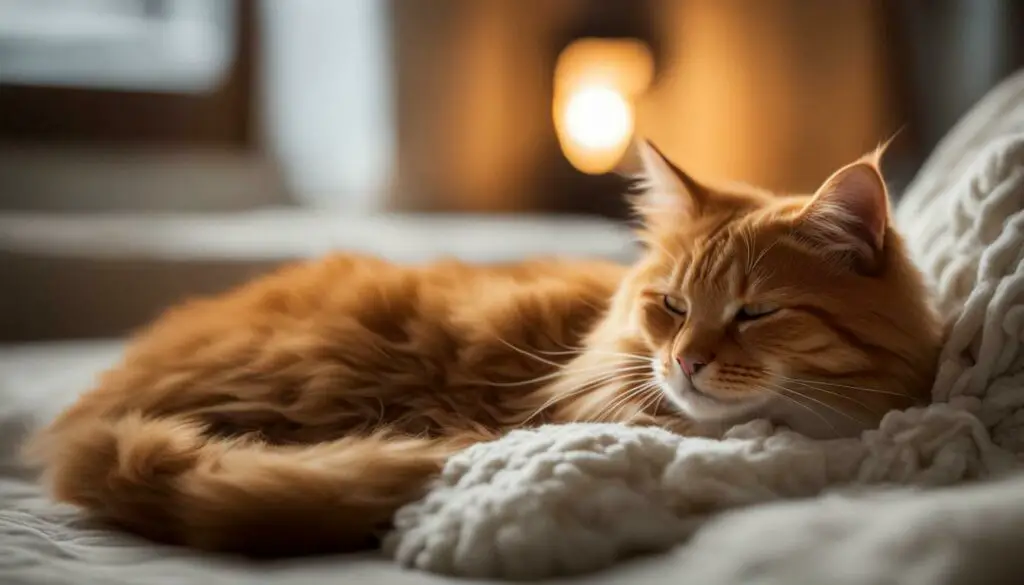
| Sleeping Position | Meaning |
|---|---|
| Curling into a ball | A sign of relaxation and security |
| Sleeping belly up | Indicates a high level of trust and vulnerability |
| Sleeping in a loaf position | A comfortable sleeping position where the cat is ready to spring into action if needed |
In summary, cats sleep pressed up against their owners for various reasons. It provides them with comfort, warmth, and a sense of security. It also strengthens the bond between cats and their owners. However, it’s important to respect a cat’s preferences and boundaries when it comes to sleeping arrangements. Understanding and catering to your cat’s needs will ensure a harmonious and loving relationship.
The Risks and Considerations
While the idea of having your feline companion sleep with you might seem cozy and comforting, it’s essential to consider the potential risks involved to ensure the safety and well-being of both you and your cat. Cats, like any other pets, have their own habits and behaviors that can pose certain challenges when sharing a sleeping space.
One of the primary concerns is the possibility of bringing contaminants onto the bed. Cats, being outdoor explorers, can carry dirt, bacteria, and even parasites on their fur and paws. These can transfer onto your bedding, leading to potential health issues for both you and your cat. It’s important to regularly groom and check your cat for any signs of fleas, ticks, or other pests to minimize the risk.
Accidental harm during sleep is also a consideration. Cats, known for their agility and nocturnal nature, may move around during the night, potentially scratching or clawing at their owners unintentionally. It’s essential to ensure that both you and your cat have enough space to sleep comfortably without the risk of accidental injuries.
Despite these risks, many cat owners find great joy and comfort in sharing their sleeping space with their feline companions. By taking necessary precautions and maintaining a clean and safe sleeping environment, you can create a positive experience for both you and your cat.
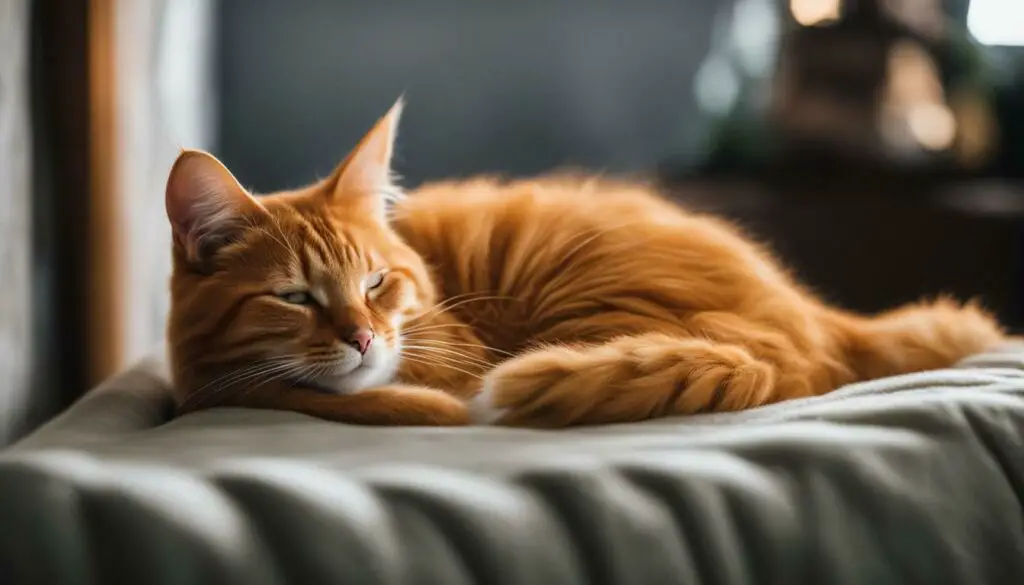
| Risks | Considerations |
|---|---|
| Contaminants on bedding | Regular grooming and checking for pests |
| Accidental harm during sleep | Providing enough space for both you and your cat |
Face Down Sleeping: What Does it Mean?
Have you ever noticed your cat sleeping face down, with their little paws tucked under them? Let’s delve into the meaning behind this intriguing sleeping position. Cats are known for their unique sleeping habits and positions, and sleeping face down is just one of them.
When a cat sleeps with their face down and paws tucked under them, it usually indicates a sense of security and comfort. This position allows them to feel protected and hidden, as if they are in their own little safe haven. Cats are instinctively cautious animals, and this sleeping position reflects their need for security.
Additionally, sleeping face down can help cats block out light and noise, allowing them to achieve a deeper and more restful sleep. By burying their faces and ears in this position, cats can create a cocoon-like environment that shields them from external stimuli. It also serves as a way to keep their noses warm, as cats are sensitive to changes in temperature.
Overall, if your cat sleeps face down, it’s a sign that they feel safe, comfortable, and secure in their surroundings. It’s important to provide them with a cozy sleeping area that meets their needs, such as a soft bed or a warm blanket where they can curl up and sleep in their preferred position.
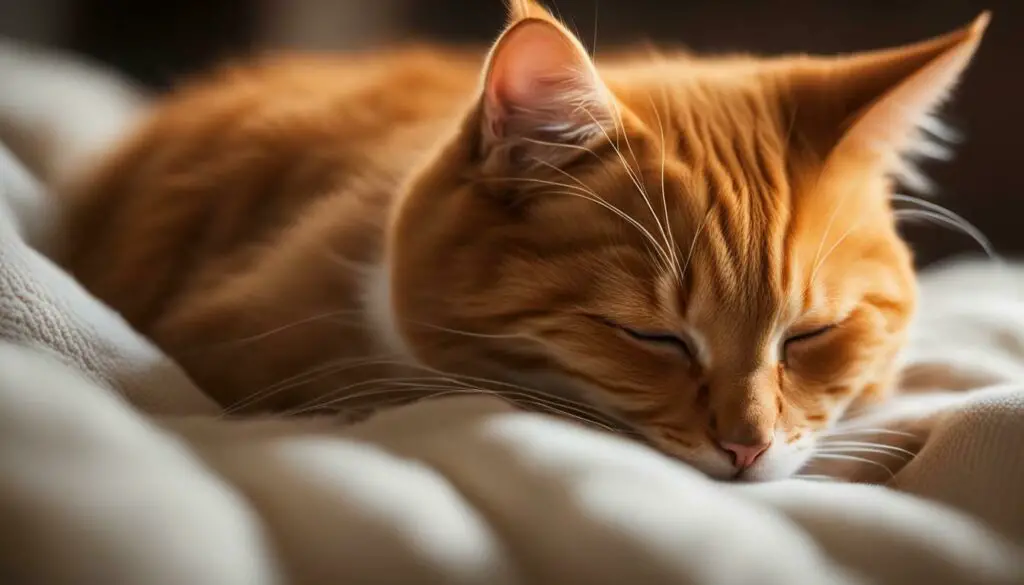
| Sleeping Positions | Meaning |
|---|---|
| Curling into a ball | A sign of conserving heat and feeling protected. |
| Sleeping belly up | Indicates trust and complete relaxation. |
| Sleeping in a loaf position | Shows a sense of comfort and ease. |
As with any behavior, it’s important to remember that individual cats may have their own preferences when it comes to sleeping positions. Some cats may enjoy sleeping face down, while others may prefer different positions. Paying attention to your cat’s sleeping habits can help you better understand their needs and provide them with a comfortable environment for restful sleep.
Creating a Cat-Friendly Sleeping Area
Just like humans, cats also need a comfortable and inviting sleeping area to enjoy a restful slumber. Let’s explore how you can create an optimal sleeping environment for your feline friend.
Start by choosing a quiet and secluded spot for your cat’s bed or sleeping area. Cats appreciate a sense of privacy, so placing their bed in a peaceful corner away from noise and distractions will help promote better sleep. Additionally, ensure that the sleeping area is away from drafts and direct sunlight, as cats prefer a cozy and warm sleeping spot.
Providing a soft and cushioned bed or blanket is essential for your cat’s comfort. Look for beds that are made of plush materials and have sufficient padding to support your cat’s body. You can also add a familiar-smelling blanket or piece of clothing to create a sense of security and familiarity for your cat.
| Tip | Benefit |
|---|---|
| 1. Place the bed at a higher level | Cats love to perch and observe their surroundings, so elevating their sleeping area can provide them with a sense of security and a better vantage point. |
| 2. Consider a heated bed | Cats are naturally drawn to warmth, and providing a heated bed can be especially comforting for them, particularly during colder months. |
| 3. Offer a variety of sleeping options | Some cats prefer to stretch out, while others prefer to curl up. Provide different types of beds or sleeping surfaces to cater to your cat’s individual sleeping preferences. |
Remember to regularly clean and wash your cat’s sleeping area to maintain hygiene and freshness. Cats are known to be clean animals, and a clean sleeping environment is important for their overall well-being.
By creating a cat-friendly sleeping area, you can ensure that your feline companion has a comfortable and inviting space to rest and rejuvenate, promoting their health and happiness.
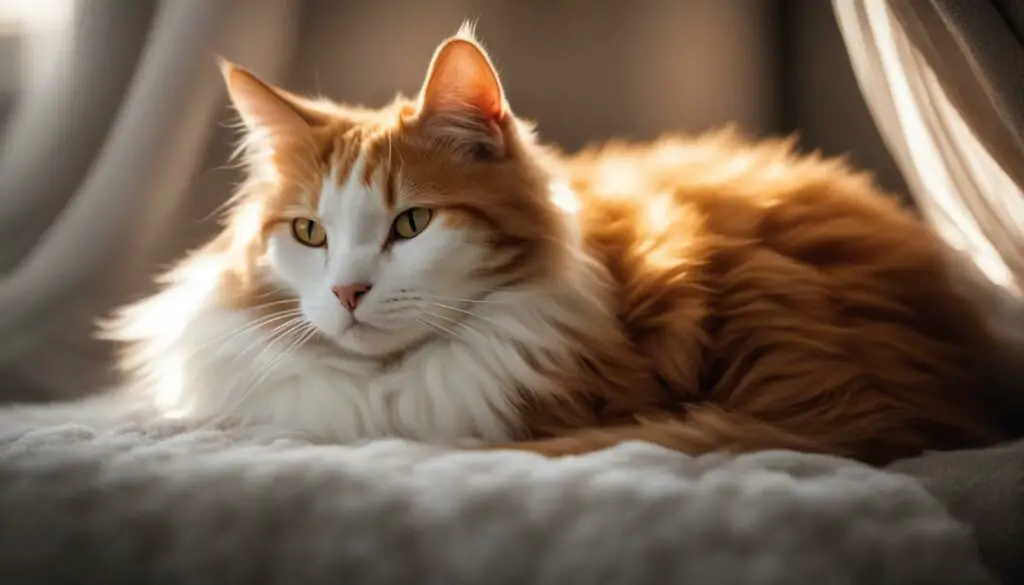
Exploring Different Sleeping Positions
Cats have a knack for finding the most adorable and sometimes peculiar sleeping positions. Let’s take a closer look at the different ways cats like to snooze and what they might indicate.
One common sleeping position that cats adopt is curling into a ball. This position helps them conserve body heat and protect their vital organs. When a cat curls up tightly, it can also indicate that they are feeling secure and content. It’s their way of creating a cozy and safe sleeping environment.
Another position you may often see your cat in is sleeping belly up. When a cat sleeps in this position, it usually means they feel completely relaxed. Exposing their belly is a vulnerable position for a cat, so when they sleep in this way, it shows that they trust their surroundings and feel safe.
Some cats prefer to sleep in a loaf position, where they tuck their paws underneath their bodies and rest their heads on their paws. This position allows them to conserve body heat while still being ready to spring into action if needed. It’s a comfortable and alert sleeping position for cats.
| Sleeping Position | Meaning |
|---|---|
| Curling into a ball | Feeling secure and content |
| Sleeping belly up | Feeling relaxed and safe |
| Loaf position | Comfortable and alert |
Remember, each cat is unique, and their sleeping positions may vary depending on their mood, comfort level, and environment. It’s important to observe your cat’s preferences and provide them with a cozy and inviting sleeping area that meets their needs. By understanding their sleeping positions, we can better understand our feline friends and ensure they have a restful and peaceful night’s sleep.
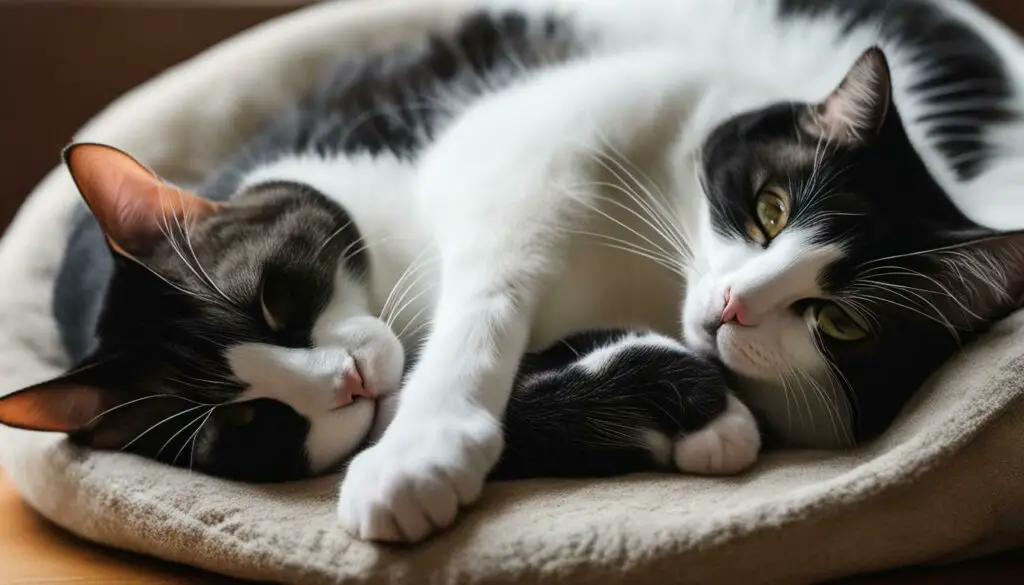
Differentiating Face Down Sleeping from Head Pressing
While cats sleeping face down is usually harmless and perfectly normal, it’s crucial to identify the difference between this position and head pressing, which could be a sign of underlying health issues. Cats enjoy sleeping in various positions, and some may find comfort in sleeping with their faces down. This position allows them to block out light or keep their noses warm. However, it is important to monitor their behavior closely to ensure it does not progress into head pressing.
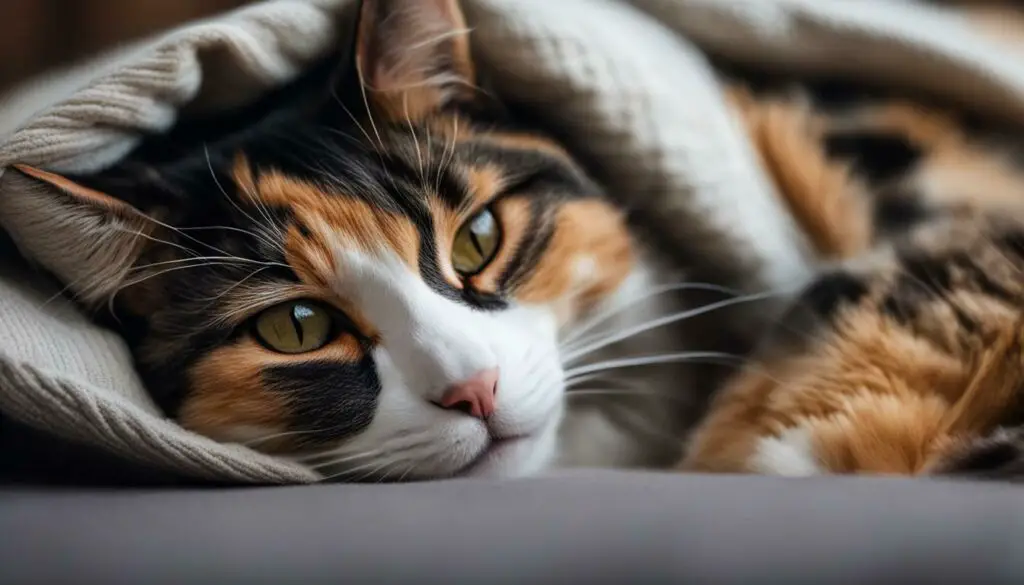
Head pressing, on the other hand, is a behavior where a cat continuously presses their head against a wall, furniture, or any other solid object. This is not a normal sleeping position and can indicate neurological damage or an underlying health issue. If you notice your cat engaging in this behavior, it is essential to consult a veterinarian for a proper evaluation.
Understanding the difference between face down sleeping and head pressing is crucial for the well-being of your cat. By being observant and aware of their behavior, you can ensure that they are enjoying a comfortable sleep without any potential health concerns.
| Signs of Face Down Sleeping | Signs of Head Pressing |
|---|---|
|
|
Quote:
“Observing your cat’s sleeping position and behavior can provide valuable insights into their overall health and well-being.” – Dr. Jane Scott, Veterinary Behaviorist
The Significance of Owner Bonding
Sharing a sleeping space with your cat not only provides physical comfort but also deepens the emotional bond between you and your feline companion. When your cat chooses to sleep pressed up against you, it is a clear indication of trust and affection. Cats are known to be independent creatures, so when they seek close proximity during sleep, it is a special moment of connection.
Cat owner bonding is built on mutual trust and companionship. Allowing your cat to sleep with you creates a sense of security for them, as they feel protected and safe in your presence. This feeling of trust translates into a stronger bond between you and your furry friend.
Cuddling and sleeping together also release oxytocin, also known as the “love hormone,” in both you and your cat. This hormone promotes feelings of attachment and deepens the emotional connection. It’s a beautiful way to strengthen the bond and show your cat that they are not just a pet, but an important member of your family.
As you and your cat sleep side by side, it establishes a daily ritual of togetherness. This routine can be comforting and reassuring for both of you, reducing stress and promoting overall well-being. The shared sleeping space becomes a sanctuary for relaxation, where you can both unwind and find solace in each other’s company.
“There is no psychiatrist in the world like a puppy licking your face.”
– Ben Williams
| Sleeping Position | Meaning |
|---|---|
| Curling into a ball | A sign of comfort and protection |
| Sleeping belly up | Shows complete trust and relaxation |
| Sleeping in a loaf position | A sign of contentment and security |
Remember, every cat is unique, and their sleeping preferences may vary. Some cats may prefer to sleep closer to their owners, while others may opt for a separate sleeping spot nearby. It’s essential to respect your cat’s choices and create a sleeping environment that caters to their individual needs.
By nurturing the bond through shared sleep, you create a space where love, trust, and comfort flourish. Cherish these moments with your cat, as they are a testament to the beautiful companionship you share.
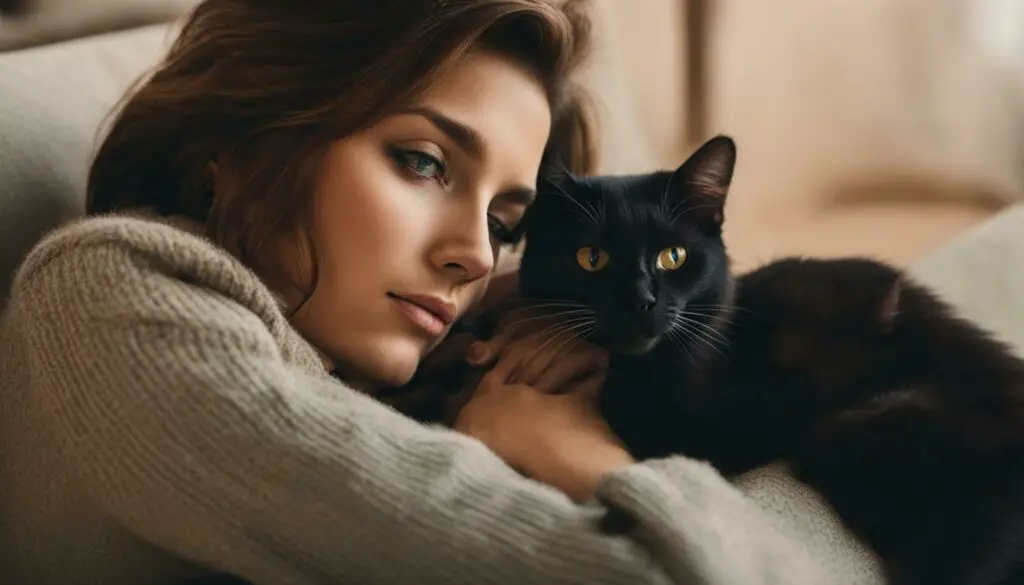
Responsible Sleeping Arrangements
While sleeping with your cat can be a wonderful experience, it’s crucial to find a balance that ensures both your comfort and your beloved feline’s well-being. Here are some tips for maintaining responsible sleeping arrangements:
- Allergies: If you or your partner have allergies, it may be best to avoid sharing the bed with your cat. Consider creating a separate sleeping space for your furry friend, such as a cozy cat bed nearby.
- Personal Sleep Preferences: Some cats may be more active or restless during the night, which can disrupt your sleep. In such cases, you may choose to restrict your cat’s access to the bedroom or use a baby gate to create a designated sleeping area.
- Safety: Ensure that your sleeping environment is safe for both you and your cat. Keep any hazardous items, such as loose wires or small objects, out of reach. Also, be mindful of your cat’s movements during sleep to prevent accidental harm.
- Hygiene: Regularly clean your bedding to minimize the risk of allergens, pet dander, or contaminants being brought into your bed. It’s a good practice to wash your sheets and pillowcases at least once a week.
- Respecting Your Cat’s Choice: Some cats may prefer their own sleeping spaces and may not enjoy sleeping with their owners. Respect your cat’s boundaries and provide alternative comfortable sleeping options, such as a cozy cat condo or a soft blanket.
Creating a Cat-Friendly Sleeping Area:
In order to ensure your cat has a comfortable sleeping area, consider the following:
- Lighting: Create a dim and peaceful sleeping environment for your cat. Consider using blackout curtains or night lights to provide a soothing atmosphere.
- Temperature: Cats prefer warm sleeping spots. Make sure the room temperature is regulated and comfortable, especially during colder months. Provide cozy blankets or heated cat beds for extra warmth if needed.
- Bedding: Choose bedding materials that are soft, hypoallergenic, and easy to clean. Cats may appreciate bedding with a gentle texture, such as fleece or microfiber.
- Personalization: Add familiar scents, such as your cat’s favorite blanket or a piece of your clothing, to their sleeping area. This can provide a sense of comfort and security.
Remember, each cat is unique, and their sleeping preferences may vary. Pay attention to your cat’s behavior and adjust their sleeping arrangements accordingly. By creating a safe and comfortable sleeping space for your feline friend, you can ensure a good night’s rest for both of you.
| Pro Tip: | To protect your bedding from cat hair and scratches, consider using a washable cover for your pillows and duvet. This will make cleaning easier and prevent any damage to your bedding. |
|---|
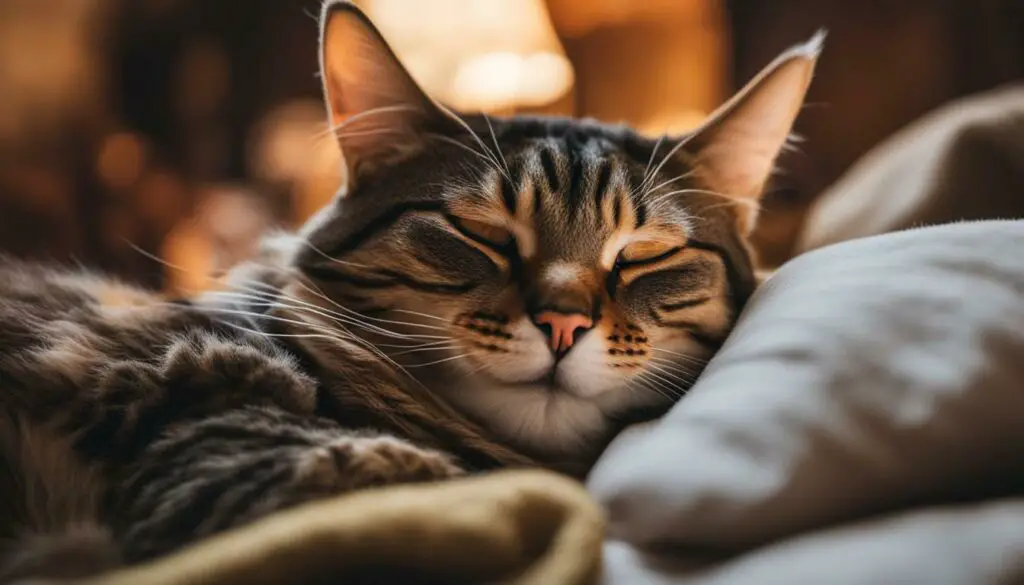
Encouraging Healthy Sleeping Habits
Just like humans, cats benefit from a good night’s sleep. Let’s explore some ways you can promote healthy sleeping habits for your furry friend.
1. Provide a comfortable sleeping area: Cats appreciate a cozy and quiet space to rest. Ensure your cat has a soft and clean bed or blanket to sleep on. Consider placing it in a secluded area away from noise and distractions.
2. Maintain a consistent routine: Cats thrive on routine, so establish a regular sleep schedule for your cat. Try to stick to the same bedtime and wake-up time every day. This will help regulate their internal clock and promote better sleep.
3. Create a calming environment: Make your cat’s sleeping area as peaceful and relaxing as possible. Consider using a diffuser with calming essential oils or playing soft and soothing music to create a serene atmosphere.
4. Engage in playtime: Regular play sessions during the day can help tire out your cat and promote better sleep at night. Use interactive toys and engage in active play to keep your cat physically and mentally stimulated.
Remember, every cat is unique, and their sleeping preferences may vary. Pay attention to your cat’s individual needs and adjust accordingly. By promoting healthy sleeping habits, you can ensure that your cat gets the restful sleep they need to maintain optimal health and well-being.
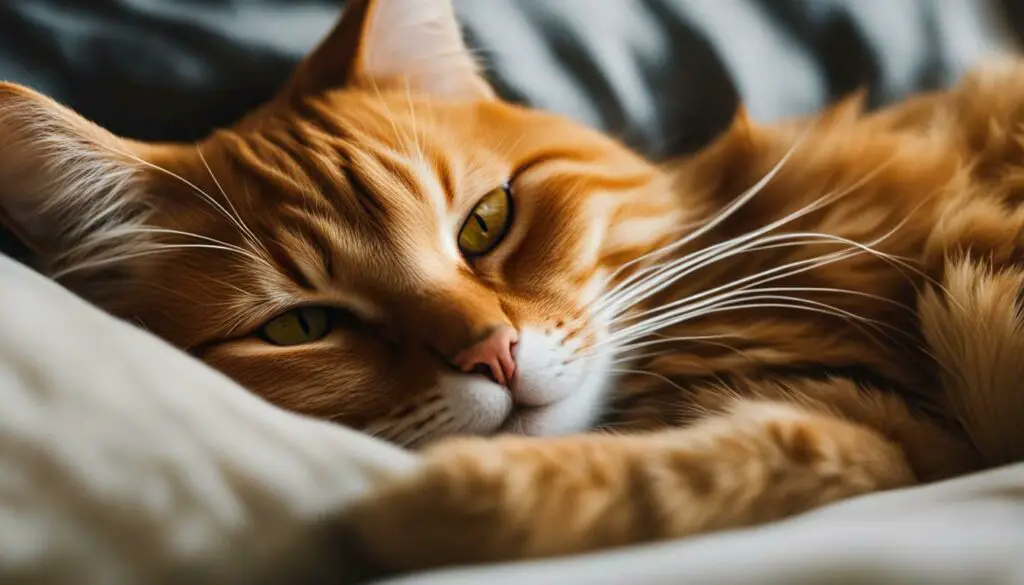
Table: Common Cat Sleeping Positions
| Position | Description |
|---|---|
| Curled into a ball | Cat curls up with their tail wrapped around their body, resembling a ball. |
| Sleeping belly up | Cat lies on their back with their belly exposed, indicating a sense of trust and relaxation. |
| Sleeping in a loaf position | Cat tucks all their legs underneath their body, resembling a loaf of bread. |
“A well-rested cat is a happy cat.”
Understanding and promoting healthy sleeping habits in your cat can contribute to their overall well-being. By providing a comfortable sleeping area, maintaining a consistent routine, creating a calming environment, and engaging in playtime, you can help your furry friend enjoy quality sleep. Remember to observe your cat’s individual sleeping preferences and adjust accordingly. Here’s to peaceful nights and contented cats!
Conclusion
Understanding why your cat sleeps pressed up against you is a fascinating journey into the intricate world of feline behavior, showcasing the depth of connection and trust between cats and their owners. Cats exhibit this behavior for various reasons, including trust and safety, seeking warmth and comfort, marking territory and showing affection, and seeking comfort and reassurance during times of stress.
While allowing your cat to sleep with you can strengthen your bond, it’s important to consider the risks associated with this arrangement. Bringing contaminants onto the bed and accidental harm during sleep are potential concerns that require responsible decision-making. It’s up to you, as the owner, to determine what sleeping arrangement works best for you and your cat.
When it comes to sleeping positions, cats have their preferences. Whether they curl into a ball, sleep belly up, or assume a loaf position, each choice has its significance. Creating a cat-friendly sleeping area with appropriate lighting and temperature can ensure your cat gets a comfortable and restful night’s sleep.
It’s essential to differentiate between cats sleeping face down and exhibiting head pressing, as the latter can indicate neurological damage and should be checked by a veterinarian. By paying attention to your cat’s sleeping habits and behaviors, you can deepen your understanding of their needs and strengthen your owner-cat bond.
FAQ
Why does my cat sleep pressed up against me?
Cats sleep pressed up against their owners for various reasons. One reason is that they trust their owners and feel safe around them. They may also do it for warmth, as cats love anything warm and sleeping close to their owners provides that warmth. Cats may also sleep pressed against their owners to mark them as their territory or to show affection. They may seek comfort and reassurance from their owners during times of stress.
Are there any risks to letting cats sleep with their owners?
While there are risks to letting cats sleep with their owners, such as bringing contaminants onto the bed or accidental harm during sleep, it is ultimately up to the owner to decide if they want to allow their cat to sleep with them. It is important to weigh the potential risks against the benefits of bonding and companionship.
Why do some cats sleep face down?
Some cats may sleep face down as a comfortable sleeping position for them. It can help block out light or keep their noses warm. Sleeping face down does not necessarily indicate any health problems or abnormalities.
What are common sleeping positions for cats?
Cats can have various sleeping positions, including curling into a ball, sleeping belly up, or sleeping in a loaf position. These positions can vary among individual cats and may change based on their mood or the environment.
How can I create a cat-friendly sleeping area?
To create a cat-friendly sleeping area, make sure to provide appropriate lighting and temperature. Cats generally prefer a warm and cozy sleeping environment. Consider providing a comfortable bed or blanket specifically for your cat to sleep on.
What should I do if my cat exhibits head pressing while sleeping?
If your cat exhibits head pressing, it can be a sign of neurological damage or other underlying health issues. It is important to consult a veterinarian to rule out any potential medical conditions.

